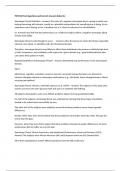Exam (elaborations)
PSY5330 Test Questions and Correct Answers Rated A+
- Course
- Institution
PSY5330 Test Questions and Correct Answers Rated A+ Stereotype Threat Definition - Answers The event of a negative stereotype about a group to which one belongs becoming self-relevant, usually as a plausible interpretation for something one is doing, for an experience one is having, or for a situa...
[Show more]



